《药理学》课程教学课件(PPT讲稿)Section 1 Basic Principles of Pharmacology
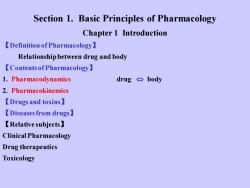
Section 1.Basic Principles of Pharmacology Chapter 1 Introduction 【Definition of Pharmacology】 Relationship between drug and body 【Contents of Pharmacology】 1.Pharmacodynamics drug台body 2.Pharmacokinemics 【Drugs and toxins】 【Diseases from drugs.】 【Relative subjects】 Clinical Pharmacology Drug therapeutics Toxicology
Section 1. Basic Principles of Pharmacology Chapter 1 Introduction 【Definition of Pharmacology】 Relationship between drug and body 【Contents of Pharmacology】 1. Pharmacodynamics drug body 2. Pharmacokinemics 【Drugs and toxins】 【Diseases from drugs】 【Relative subjects】 Clinical Pharmacology Drug therapeutics Toxicology

Chapter 2 Pharmacodymamics 【Characteristics of drug effects】 Modulate the original function of body: Excitation or Inhibition 【Selectivity of drug effects】 For any drug:comparable;depending on properties of drug,dose,and routes 【Consequences of drug actions】 1.Therapeutic effect Purposes inc.etiological and symptomatic 2.Untoward reaction 1)Side reaction 2)Toxic reaction inc.acute,chronic,and unusual toxicities(carcinogenesis, teratogenesis,mutagenesis,reproductive toxicity,etc) 3)After effect(residual effect) 4)Allergic reaction and idiosyncratic reaction 5)Dependence of drugs 【Dose-effect relationship】 1.Graded dose-response relationship
Chapter 2 Pharmacodymamics 【Characteristics of drug effects】 Modulate the original function of body: Excitation or Inhibition 【Selectivity of drug effects】 For any drug: comparable; depending on properties of drug, dose, and routes 【Consequences of drug actions】 1. Therapeutic effect Purposes inc. etiological and symptomatic 2. Untoward reaction 1) Side reaction 2) Toxic reaction inc. acute, chronic, and unusual toxicities (carcinogenesis, teratogenesis, mutagenesis, reproductive toxicity, etc) 3) After effect (residual effect) 4) Allergic reaction and idiosyncratic reaction 5) Dependence of drugs 【Dose-effect relationship】 1. Graded dose-response relationship
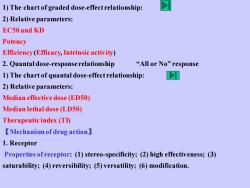
1)The chart of graded dose-effect relationship: 2)Relative parameters: EC50 and KD Potency Efficiency(Efficacy,Intrinsic activity) 2.Quantal dose-response relationship “All or No”response 1)The chart of quantal dose-effect relationship: 2)Relative parameters: Median effective dose(ED50) Median lethal dose(LD50) Therapeutic index(TD) 【Mechanism of drug action】 1.Receptor Properties of receptor:(1)stereo-specificity;(2)high effectiveness;(3) saturability;(4)reversibility;(5)versatility;(6)modification
1) The chart of graded dose-effect relationship: 2) Relative parameters: EC50 and KD Potency Efficiency (Efficacy, Intrinsic activity) 2. Quantal dose-response relationship “All or No” response 1) The chart of quantal dose-effect relationship: 2) Relative parameters: Median effective dose (ED50) Median lethal dose (LD50) Therapeutic index (TI) 【Mechanism of drug action】 1. Receptor Properties of receptor: (1) stereo-specificity; (2) high effectiveness; (3) saturability; (4) reversibility; (5) versatility; (6) modification

2.Ligand Binding with special receptor;Standard:high affinity to receptor 1)Full agonist 2)Partial agonist 3)Antagonist 4)Partialinverse agonist 5)Full inverse agonist 3.Evaluation parameters of affinity 1)PD2 2)pA2 4.Drug-Receptor Theory 1)Occupation theory ClarkA.J.(1933) V L R=LR- E V2 Vi=k1-[L][R],v2=k-[LR],k2/k=KD=[L].[RV/[LR],[LR]=[L].[RJ/KD
2. Ligand Binding with special receptor; Standard: high affinity to receptor 1) Full agonist 2) Partial agonist 3) Antagonist 4) Partial inverse agonist 5) Full inverse agonist 3. Evaluation parameters of affinity 1) PD2 2) pA2 4. Drug-Receptor Theory 1) Occupation theory Clark A.J. (1933) V1 L + R = LR - E V2 v1=k1 .[L][R], v2=k2 .[LR], k2 /k1=KD= [L].[R]/[LR], [LR] = [L].[R]/KD
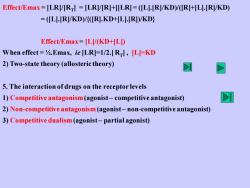
Effect/Emax=[LRJ/[RTl [LR]/[R]+[[LR]=([L].[R]/KD)/([R]+[L].[R]/KD) =([L].[RJ/KD)/([R].KD+[L].[RJ/KD) Effect/Emax=[L]/(KD+[L]) When effect=.Emax,ie [LR]=1/2.[R],[L]=KD 2)Two-state theory (allosteric theory) G 5.The interaction of drugs on the receptor levels 1)Competitive antagonism(agonist-competitive antagonist) I 2)Non-competitive antagonism(agonist-non-competitive antagonist) 3)Competitive dualism(agonist-partial agonist)
Effect/Emax = [LR]/[RT ] = [LR]/[R]+[[LR] = ([L].[R]/KD)/([R]+[L].[R]/KD) = ([L].[R]/KD)/{([R].KD+[L].[R])/KD} Effect/Emax= [L]/(KD+[L]) When effect = ½.Emax, ie [LR]=1/2.[ RT ] , [L]=KD 2) Two-state theory (allosteric theory) 5. The interaction of drugs on the receptor levels 1) Competitive antagonism(agonist – competitive antagonist) 2) Non-competitive antagonism (agonist – non-competitive antagonist) 3) Competitive dualism(agonist – partial agonist)
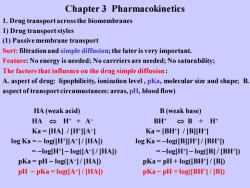
Chapter 3 Pharmacokinetics 1.Drug transport across the biomembranes 1)Drug transport styles (1)Passive membrane transport Sort:filtration and simple diffusion;the later is very important. Feature:No energy is needed;No carrriers are needed;No saturability; The factors that influence on the drug simple diffusion: A.aspect of drug:lipophilicity,ionization level,pKa,molecular size and shape;B. aspect of transport circumustances:areas,pH,blood flow) HA(weak acid) B(weak base) HA台H++A BH+台B+H Ka=[HA]/[H+][A-] Ka=BH/BH剀 log Ka=-l0g([H+][A-]/[HA]) log Ka=-log([B][H+]/[BH+]) =-log[H+]-log([A-]/[HA]) =-log[H+]-log([B]/[BH+]) pKa=pH-log([A-]/[HA]) pKa=pH+log(BH中/[B) pH -pKa=log([A-]/[HA]) pKa-pH=log([BH+]/[BD)
Chapter 3 Pharmacokinetics 1. Drug transport across the biomembranes 1) Drug transport styles (1) Passive membrane transport Sort: filtration and simple diffusion; the later is very important. Feature: No energy is needed; No carrriers are needed; No saturability; The factors that influence on the drug simple diffusion: A. aspect of drug: lipophilicity, ionization level , pKa, molecular size and shape; B. aspect of transport circumustances: areas, pH, blood flow) HA (weak acid) B (weak base) HA H+ + A− BH+ B + H+ Ka = [HA] / [H+ ][A− ] Ka = [BH+ ] / [B][H+ ] log Ka = − log([H+ ][A− ]/ [HA]) log Ka = −log([B][H+ ]/ [BH+ ]) = −log[H+ ] − log([A− ] / [HA]) = −log[H+ ] − log([B] / [BH+ ]) pKa = pH − log([A− ]/ [HA]) pKa = pH + log([BH+ ] / [B]) pH − pKa = log([A− ] / [HA]) pKa − pH = log([BH+ ] / [B])
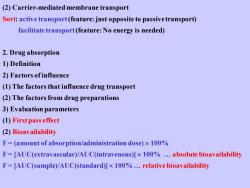
(2)Carrier-mediated membrane transport Sort:active transport(feature:just opposite to passive transport) facilitate transport(feature:No energy is needed) 2.Drug absorption 1)Definition 2)Factors ofinfluence (1)The factors that influence drug transport (2)The factors from drug preparations 3)Evaluation parameters (1)First pass effect (2)Bioavailability F=(amount of absorption/administration dose)x 100% F=[AUC(extravascular)/AUC(intravenous)]x 100%.absolute bioavailability F=[AUC(sample)/AUC(standard)]x 100%.relative bioavailability
(2) Carrier-mediated membrane transport Sort: active transport(feature: just opposite to passive transport) facilitate transport(feature: No energy is needed) 2. Drug absorption 1) Definition 2) Factors of influence (1) The factors that influence drug transport (2) The factors from drug preparations 3) Evaluation parameters (1) First pass effect (2) Bioavailability F = (amount of absorption/administration dose) 100% F = [AUC(extravascular)/AUC(intravenous)] 100% . absolute bioavailability F = [AUC(sample)/AUC(standard)] 100% . relative bioavailability

3.Drug distribution 1)Definition 2)Factors ofinfluence (1)Factors that influence drug transport (2)Affinities and binding of drug to plasma proteins and special tissues or organs (3)The barriers of organs(such as blood-brain barrier,blood-eye barrier,and placenta barrier) 3)Parameters of evaluation Apparent volume of distribution(Vd) Vd total amount of drug in body/concentration of drug in plasma 4.Biotransformation 1)Definition 2)Phases of biotransformation including phase I and phase II 3)Main responsible enzymes-Cytochrome P-450 monoxygenase system,also called as hepatic microsomal drug enzymes 4)Properties of the enzymes:(1)low specificity,(2)large individual difference,(3) saturability,(4)variable activity of enzumes Inducer:phenobarbital,phenytoin,rifampin,. Inhibitor:cimetidine,isoniazid,chloromycetin
3. Drug distribution 1) Definition 2) Factors of influence (1) Factors that influence drug transport (2) Affinities and binding of drug to plasma proteins and special tissues or organs (3) The barriers of organs ( such as blood-brain barrier, blood-eye barrier, and placenta barrier) 3) Parameters of evaluation Apparent volume of distribution (Vd) Vd = total amount of drug in body/concentration of drug in plasma 4. Biotransformation 1) Definition 2) Phases of biotransformation including phase I and phase II 3) Main responsible enzymes — Cytochrome P-450 monoxygenase system, also called as hepatic microsomal drug enzymes 4) Properties of the enzymes: (1) low specificity, (2) large individual difference, (3) saturability, (4) variable activity of enzumes Inducer: phenobarbital, phenytoin, rifampin, . Inhibitor: cimetidine, isoniazid, chloromycetin,
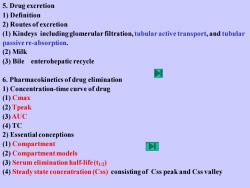
5.Drug excretion 1)Definition 2)Routes of excretion (1)Kindeys includingglomerular filtration,tubular active transport,and tubular passive re-absorption. (2)Milk (3)Bile enterohepatic recycle ☒ 6.Pharmacokinetics of drug elimination 1)Concentration-time curve of drug (1)Cmax (2)Tpeak (3)AUC (4)TC 2)Essential conceptions (1)Compartment (2)Compartment models (3)Serum elimination half-life(t12) (4)Steady state concentration(Css)consisting of Css peak and Css valley
5. Drug excretion 1) Definition 2) Routes of excretion (1) Kindeys including glomerular filtration, tubular active transport, and tubular passive re-absorption. (2) Milk (3) Bile enterohepatic recycle 6. Pharmacokinetics of drug elimination 1) Concentration-time curve of drug (1) Cmax (2) Tpeak (3) AUC (4) TC 2) Essential conceptions (1) Compartment (2) Compartment models (3) Serum elimination half-life (t1/2) (4) Steady state concentration (Css) consisting of Css peak and Css valley
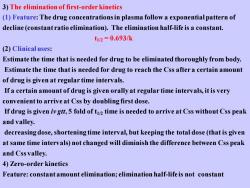
3)The elimination of first-order kinetics (1)Feature:The drug concentrations in plasma follow a exponential pattern of decline(constantratio elimination).The elimination half-life is a constant. t2=0.693/ (2)Clinical uses: Estimate the time that is needed for drug to be eliminated thoroughly from body. Estimate the time that is needed for drug to reach the Css after a certain amount of drug is given at regular time intervals. If a certain amount of drug is given orally at regular time intervals,it is very convenient to arrive at Css by doubling first dose. If drug is given iv gtt,5 fold of ti time is needed to arrive at Css without Css peak and valley. decreasing dose,shortening time interval,but keeping the total dose(that is given at same time intervals)not changed will diminish the difference between Css peak and Css valley. 4)Zero-order kinetics Feature:constant amount elimination;elimination half-life is not constant
3) The elimination of first-order kinetics (1) Feature: The drug concentrations in plasma follow a exponential pattern of decline (constant ratio elimination). The elimination half-life is a constant. t1/2 = 0.693/k (2) Clinical uses: Estimate the time that is needed for drug to be eliminated thoroughly from body. Estimate the time that is needed for drug to reach the Css after a certain amount of drug is given at regular time intervals. If a certain amount of drug is given orally at regular time intervals, it is very convenient to arrive at Css by doubling first dose. If drug is given iv gtt, 5 fold of t1/2 time is needed to arrive at Css without Css peak and valley. decreasing dose, shortening time interval, but keeping the total dose (that is given at same time intervals) not changed will diminish the difference between Css peak and Css valley. 4) Zero-order kinetics Feature: constant amount elimination; elimination half-life is not constant
按次数下载不扣除下载券;
注册用户24小时内重复下载只扣除一次;
顺序:VIP每日次数-->可用次数-->下载券;
- 《药理学》课程教学课件(PPT讲稿)β-Lactam antibiotics.ppt
- 《药理学》课程教学资源(教材讲义,英文版)药理学教材讲义(Chapter 36 -41).doc
- 《药理学》课程教学课件(PPT讲稿)Thyroid and Antithyroid Drug.ppt
- 《药理学》课程教学资源(教材讲义,英文版)药理学教材讲义(共六部分,四十一章).doc
- 《药理学》课程教学实验指导书(共十四个实验).doc
- 《药理学》课程实验指导(讲义)实验7 传出神经系统药物对麻醉兔血压的作用.doc
- 《药理学》课程实验指导(讲义)实验6 传出神经系统药物对蟾蜍腹直肌的作用.doc
- 《药理学》课程实验指导(讲义)实验5 全血水杨酸钠二室模型药动学参数测定.doc
- 《药理学》课程实验指导(讲义)实验4 肝脏功能对药物作用的影响.doc
- 《药理学》课程实验指导(讲义)实验3 不同给药途径对药物作用的影响.doc
- 《药理学》课程实验指导(讲义)实验2 药物的基本作用.doc
- 《药理学》课程实验指导(讲义)实验1 实验动物的捉持法和给药法.doc
- 《药理学》课程授课教案(讲义)麻醉性镇痛药.doc
- 《药理学》课程授课教案(讲义)平喘药.doc
- 《药理学》课程授课教案(讲义)子宫用药.doc
- 《药理学》课程授课教案(讲义)抗甲亢.doc
- 《药理学》课程授课教案(讲义)抗组胺药.doc
- 《药理学》课程授课教案(讲义)抗糖尿病药.doc
- 《药理学》课程授课教案(讲义)抗慢性心功能不全.doc
- 《药理学》课程授课教案(讲义)抗生素.doc
- 《药理学》课程教学大纲 Teaching Outline for Pharmacological Course(英文).doc
- 《药理学》课程教学大纲 Teaching Outline for Pharmacological Course(中文).doc
- 《药理学》课程教学资源(试卷习题)examination paper A(含答案).doc
- 《药理学》课程教学资源(试卷习题)examination paper B(含答案).doc
- 《临床药理学》课程教学大纲 clinical pharmacology.doc
- 《临床药理学》课程考试大纲(clinical pharmacology).doc
- 《临床药理学》课程授课教案.doc
- 《临床药理学》课程试题试卷库(无答案).doc
- 《临床药理学》课程作业习题1(无答案).doc
- 《临床药理学》课程作业习题2(无答案).doc
- 《临床药理学》课程教学课件(PPT讲稿)病理讨论2.ppt
- 《临床药理学》课程教学课件(PPT讲稿)第三章 治疗药物监测和给药个体化.ppt
- 《临床药理学》课程教学课件(PPT讲稿)第一章 绪论(石河子大学:胡艳丽).ppt
- 《临床药理学》课程教学课件(PPT讲稿)第二章 临床药代动力学.ppt
- 《临床药理学》课程教学课件(PPT讲稿)第八章 新生儿及儿童用药.ppt
- 《临床药理学》课程教学课件(PPT讲稿)第七章 妊娠期和哺乳期妇女用药.ppt
- 《临床药理学》课程教学课件(PPT讲稿)第九章 老年人用药.ppt
- 《临床药理学》课程教学课件(PPT讲稿)第十三章 药物相互作用.ppt
- 《临床药理学》课程教学课件(PPT讲稿)第十二章 药品不良反应监测与药物警戒.ppt
- 《临床药理学》课程教学课件(PPT讲稿)第十四章 药物滥用和药物依赖性.ppt
